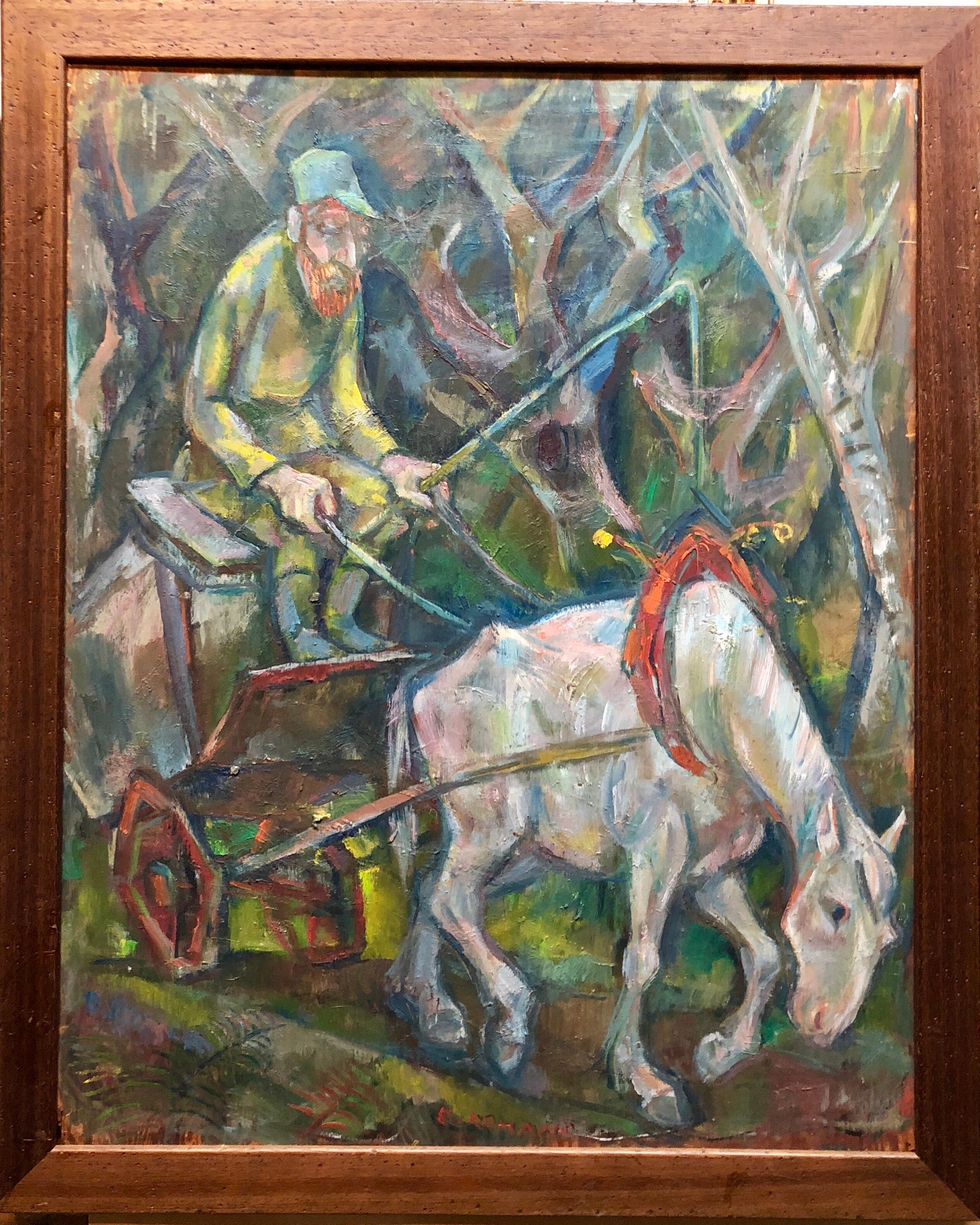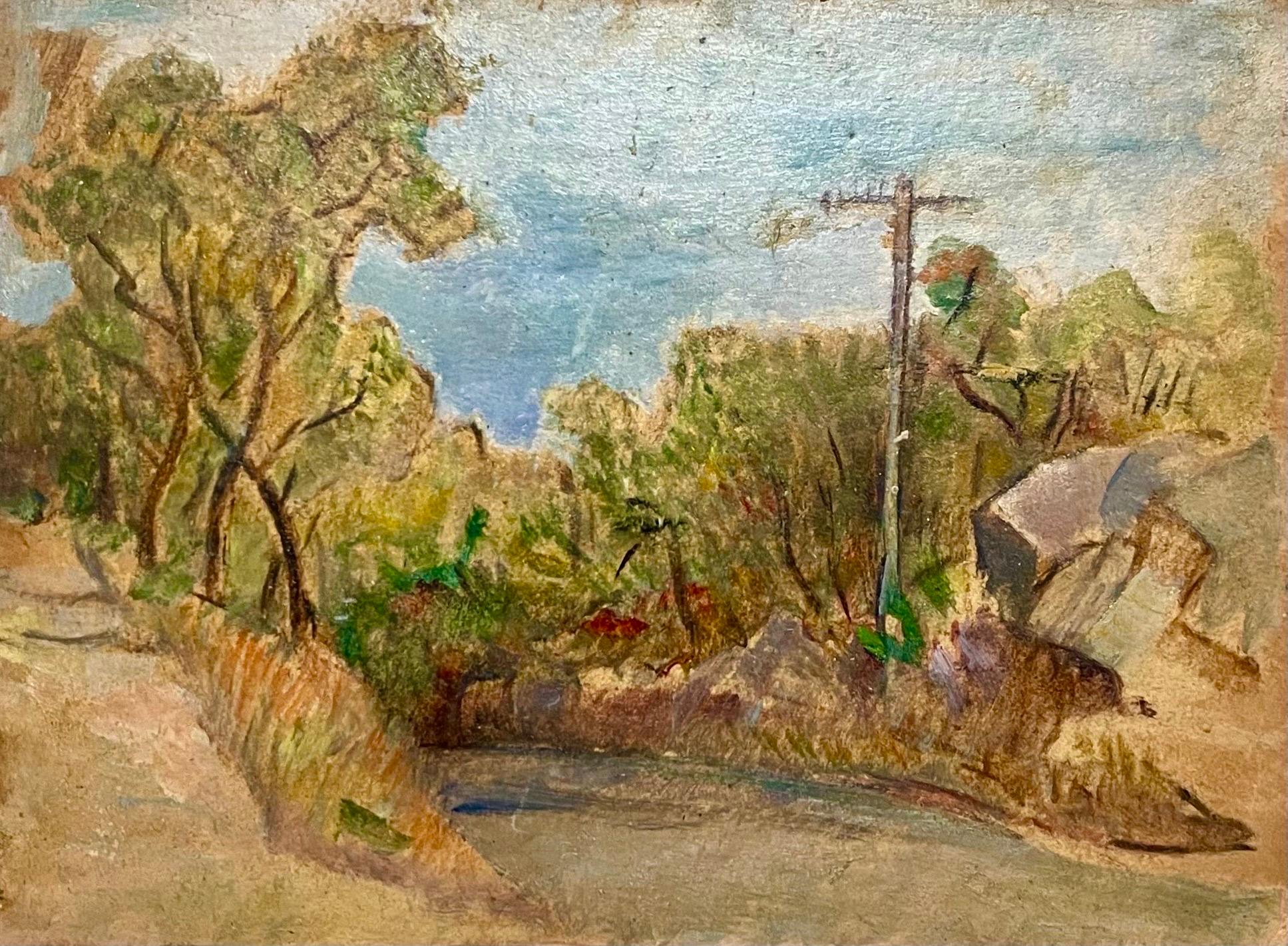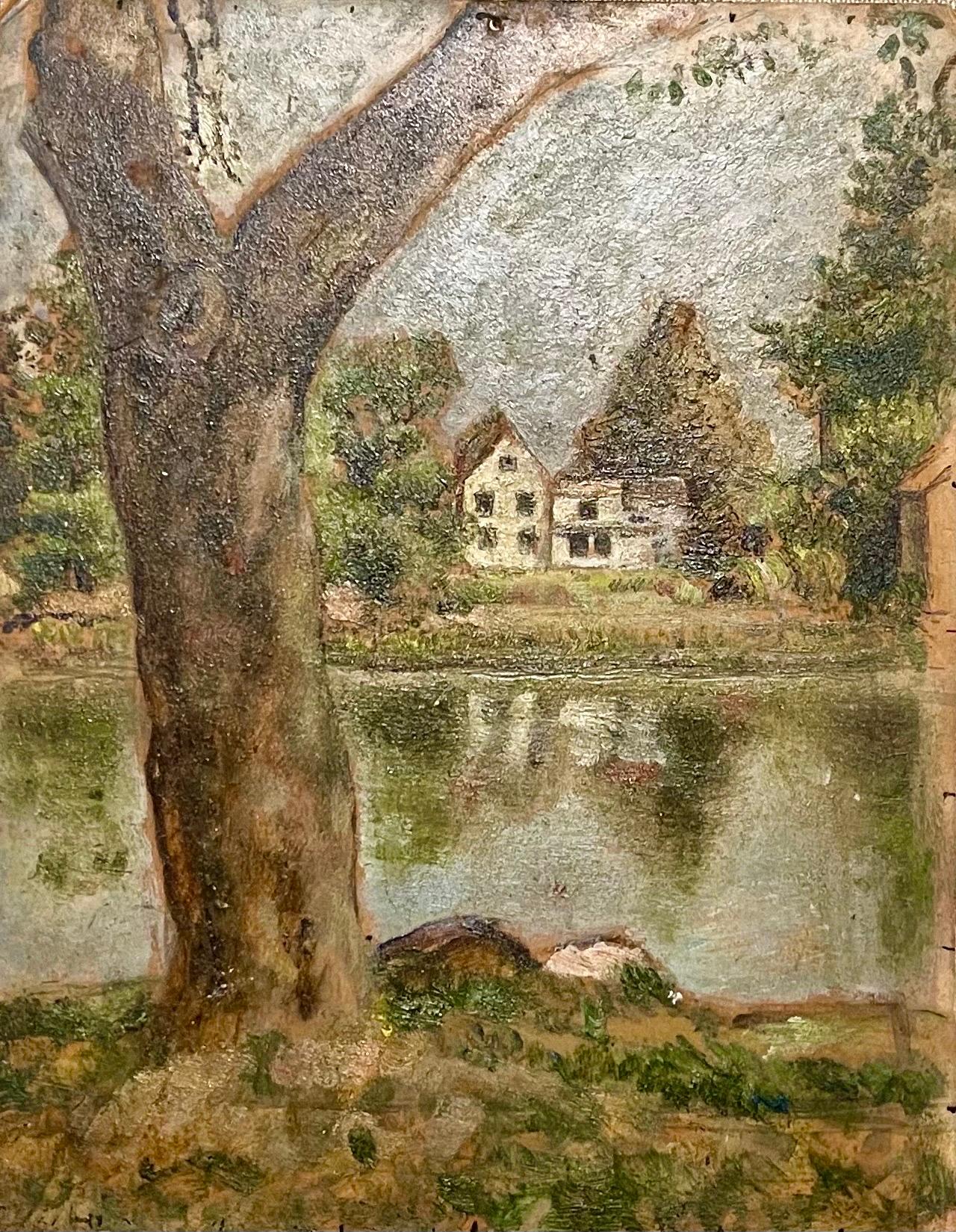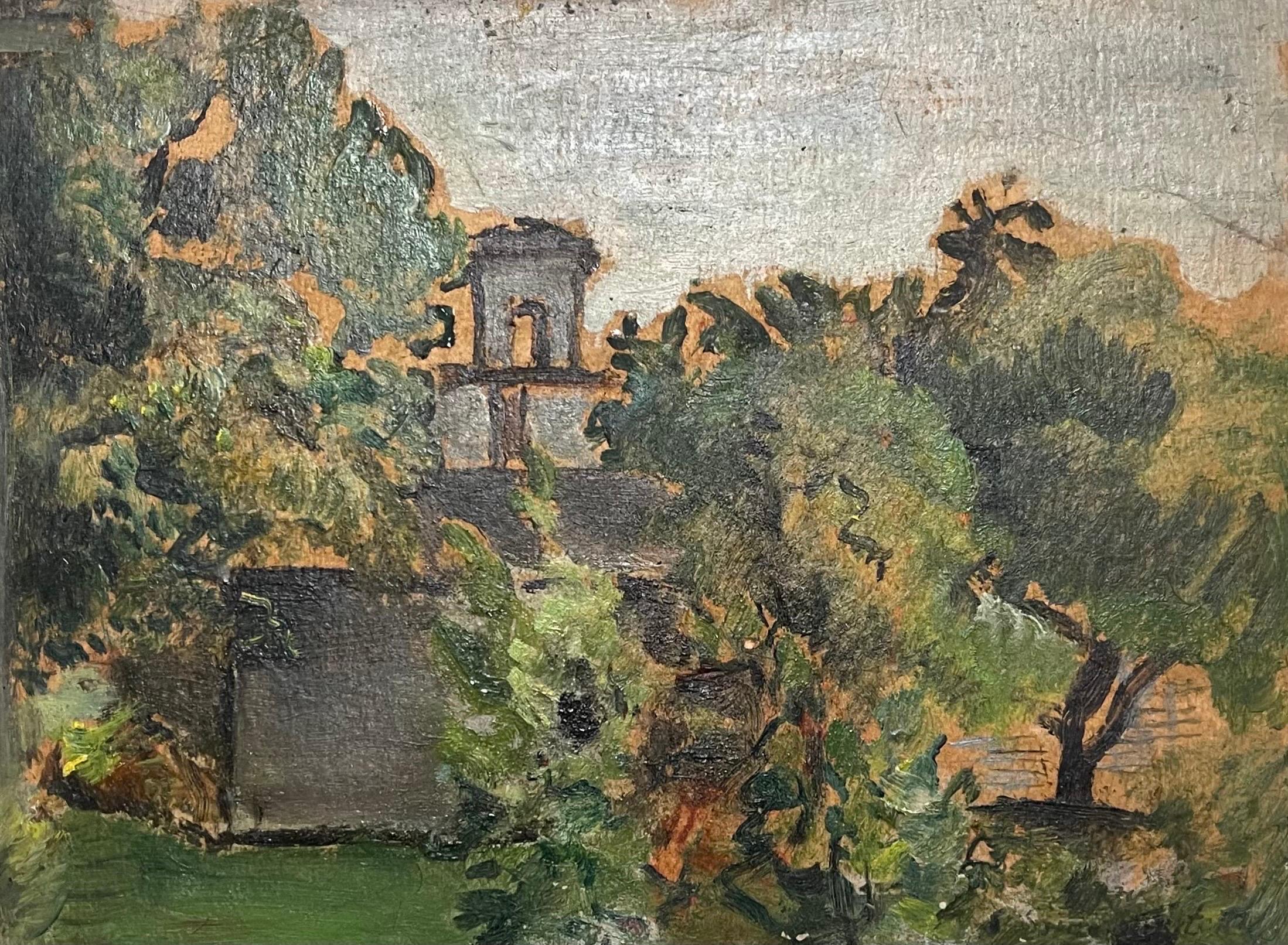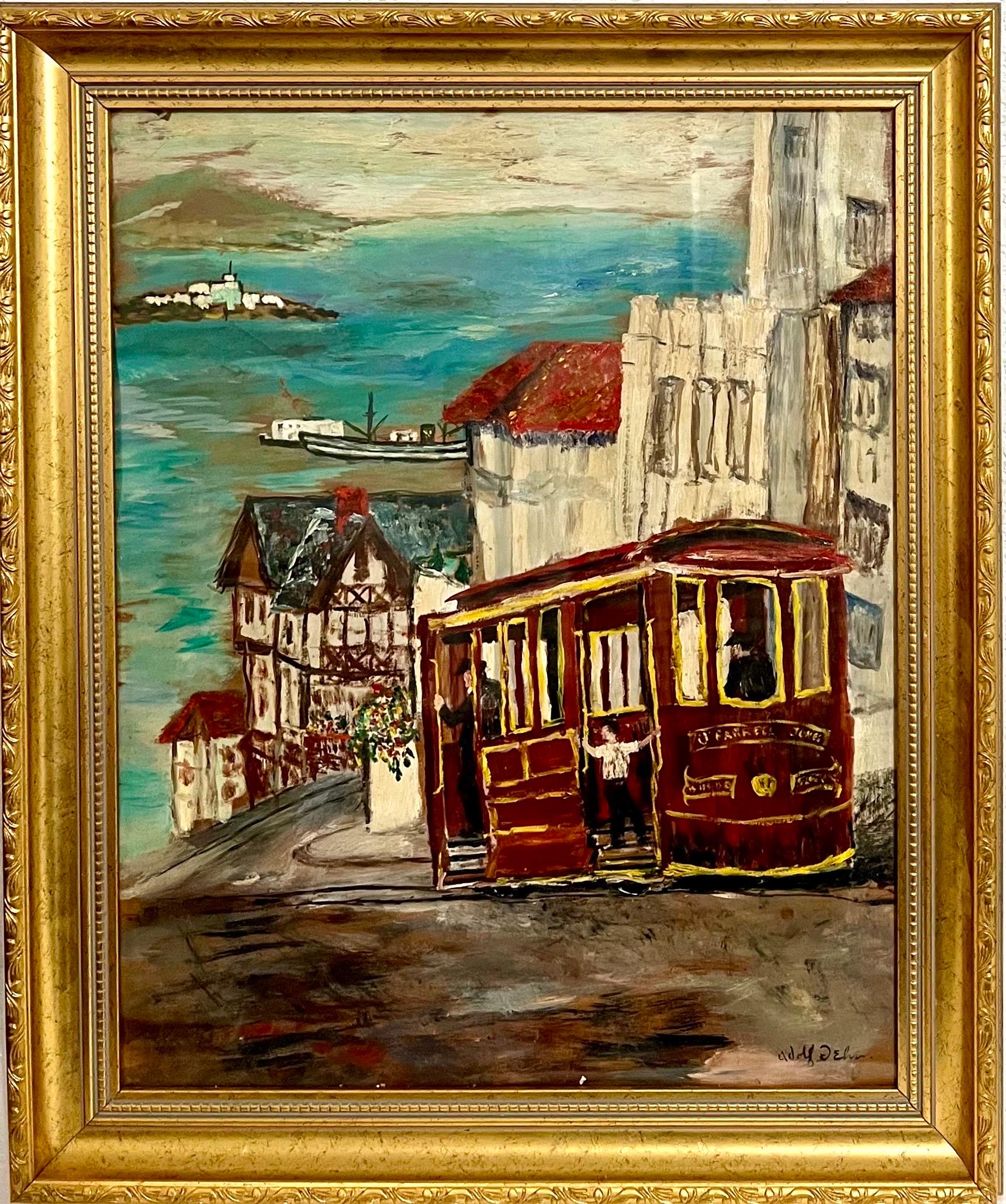Items Similar to Victor, Colorado, 1940s Modernist Mountain Landscape with Town, Mining Town
Video Loading
Want more images or videos?
Request additional images or videos from the seller
1 of 14
Martyl Suzanne Schweig LangsdorfVictor, Colorado, 1940s Modernist Mountain Landscape with Town, Mining Town1942
1942
About the Item
'Victor, Colorado', 1942 oil painting on masonite by Martyl Suzanne Schweig (1918-2013). This classic Colorado landscape was painted overlooking a ghost town with the Rocky Mountains visible across the background, completed in rich tones of green, gold, and brown. This painting was completed on a trip with fellow artist, Adolph Dehn, touring and painting Colorado Ghost towns. Presented in a custom frame, outer dimensions measure 31 ½ x 37 ½ inches. Image size is 29 ¾ x 32 ½ inches.
Victor, Colorado - the City of Gold Mines - is located at an elevation of nearly 10,000 feet on the southwest side of Pikes Peak, in the Cripple Creek Victor Mining District.
Provenance: Collection of the Artist, Martyl Suzanne Schweig
Painting is clean and in very good vintage condition - please contact us for a detailed condition report.
Expedited and international shipping is available - please contact us for a quote.
About the Artist:
Martyl Suzanne Schweig
Born: St. Louis, MO 1918
Died: Schaumburg, Illinois 2013
A plein-air landscape painter in styles of both realism and abstraction, Suzanne Schweig Langsdorf was known as Martyl, a name given to her by her artist-mother, Aimee Goldstone Schweig, for her daughter to use as an artist signature. She lived in Missouri and Illinois, although she traveled widely. Martyl was born and raised in St. Louis, and her natural talents combined with the tutelage of her mother, led to early recognition as a child artist. At age eleven, she won a first prize for drawing at a competition of the St. Louis Art Museum, and the next year she won second prize.
When she was 18 she had sold a painting to George Gershwin, and her art sold well throughout her life. Her works (which she signed simply "Martyl") have been collected by museums in Washington like the National Museum of American Art, which is part of the Smithsonian Institution, and the Hirshhorn Museum and Sculpture Garden. Martyl was a WPA (Works Progress Administration) muralist, and two of her murals are in post offices, one titled Wheat Workers in Russell, Kansas, and the other, La Guignolee, in Sainte Genevieve. Another mural, The Courageous Act of Cyrus Tiffany, completed in 1943, is in Washington DC at the Building of the Recorder of Deeds.
She spent her summers at Colorado Springs Fine Arts Center with Arnold Blanch and Boardman Robinson in 1940 and 1941, which was shortly before this painting was completed. According to the artist, she sketched for this piece while on a trip with Adolph Dehn touring many of Colorado's ghost towns during those years.
Near the end of her life, when people would inquire if she was still painting, she was known to reply with "are you still breathing?" which speaks of her lifelong love and zest for painting.
- Creator:Martyl Suzanne Schweig Langsdorf (1917 - 2013, American)
- Creation Year:1942
- Dimensions:Height: 31.5 in (80.01 cm)Width: 37.5 in (95.25 cm)Depth: 1.75 in (4.45 cm)
- Medium:
- Movement & Style:
- Period:
- Framing:Frame IncludedFraming Options Available
- Condition:very good condition.
- Gallery Location:Denver, CO
- Reference Number:
About the Seller
5.0
Platinum Seller
These expertly vetted sellers are 1stDibs' most experienced sellers and are rated highest by our customers.
Established in 1979
1stDibs seller since 2013
265 sales on 1stDibs
Typical response time: 3 hours
- ShippingRetrieving quote...Ships From: Denver, CO
- Return PolicyA return for this item may be initiated within 7 days of delivery.
More From This SellerView All
- In Soquel, California, 1950s Farm Landscape with Silo, Blue, Green, Gold, GrayBy Jon BlanchetteLocated in Denver, CO"In Soquel (California)" is an original oil on board painting by Jon Blanchette (1908-1987) circa 1955. Farm landscape with figure hanging laundry and silo, painted in colors of blue...Category
1950s American Modern Landscape Paintings
MaterialsBoard, Oil
- Near Watsonville, California, Mid Century Landscape Oil Painting House TreesBy Jon BlanchetteLocated in Denver, COMid 20th Century oil on artist board of a white house near Watsonville, California. 1950s landscape painting with house and trees. Presented in a...Category
Mid-20th Century American Modern Landscape Paintings
MaterialsBoard, Oil
- Storm Over Victor (Colorado Mountain Town), 1940s WPA Era Landscape Oil PaintingLocated in Denver, COOil on board painting by George Vander Sluis (1915-1984) titled Storm Over Victor (Colorado Mountain Town) from 1946. WPA Era Mountain Landscape wi...Category
1940s American Modern Landscape Paintings
MaterialsBoard, Oil
- Twilight of History, Figurative American Modernist Oil Painting, Gold Green RedBy Frederick ShaneLocated in Denver, CO"Twilight of History" is an original oil on board painting by Frederick Shane (1906-1992) from 1947. Shane's reflection of the twilight of our existence is shown with three creatures...Category
1940s American Modern Figurative Paintings
MaterialsBoard, Oil
- Native American Figures at Taos Pueblo, New Mexico Southwestern Oil PaintingLocated in Denver, COOriginal 20th century oil painting by Wolfgang Pogzeba (1936-1982) with Native American figures standing in bright blankets with adobe buildings in th...Category
Mid-20th Century American Modern Figurative Paintings
MaterialsOil, Canvas
- East Santa Cruz (California), Farm House with Storm Clouds Landscape PaintingBy Jon BlanchetteLocated in Denver, CO"East Santa Cruz (California)" is an oil on canvas board by Jon Blanchette (1908-1987) of a yellow farm house with dark gray storm clouds overhead. Presented in a custom frame, outer dimensions measure 21 ¾ x 25 ¾ x 1 ½ inches. Image size is 16 x 20 inches. Painting is in very good vintage condition - please contact us for a detailed condition report. Expedited and international shipping is available - please contact us for a quote. About the Artist: Jon Blanchette Born England, 1908 Died California, 1987 Jon Blanchette was born in Somerset, England on March 29, 1908. He immigrated to Battle Creek, Michigan in 1918. Artistically inclined at age six, he later studied at the Pittsburgh Art...Category
1950s American Modern Figurative Paintings
MaterialsOil, Board, Canvas
You May Also Like
- 1927 Oil Painting Eiffel Tower Paris American Modernist Wpa Artist Morris KantorBy Morris KantorLocated in Surfside, FLMorris Kantor New York (1896 - 1974) Paris from the Ile St. Louis, 1927 (view of Eiffel Tower) Oil painting on canvas Hand Signed lower left. Provenance: Hirshhorn Museum and Sculpture Garden, Smithsonian Institution ( bears label verso) Size: 20 3/4"H x 28 1/8"W (sight), 28.75 "H x 36"W (framed) Morris Kantor (Belarusian: Морыс Кантор) (1896-1974) was a Russian Empire-born American painter based in the New York City area. Born in Minsk on April 15, 1896, Kantor was brought to the United States in 1906 at age 10, in order to join his father who had previously relocated to the states. He made his home in West Nyack, New York for much of his life, and died there in 1974. He produced a prolific and diverse body of work, much of it in the form of paintings, which is distinguished by its stylistic variety over his long career. Perhaps his most widely recognized work is the iconic painting "Baseball At Night", which depicts an early night baseball game played under artificial electric light. Although he is best known for his paintings executed in a realistic manner, over the course of his life he also spent time working in styles such as Cubism and Futurism, and produced a number of abstract or non-figural works. A famous cubist, Futurist, painting of his "Orchestra" brought over 500,000$ at Christie's auction house in 2018 Kantor found employment in the Garment District upon his arrival in New York City, and was not able to begin formal art studies until 1916, when he began courses at the now-defunct Independent School of Art. He studied landscape painting with Homer Boss (1882-1956). In 1928, after returning to New York City from a year in Paris, Kantor developed a style in which he combined Realism with Fantasy, often taking the streets of New York as his subject matter. He did some moody Surrealist Nude paintings and fantasy scenes. In the 1940's he turned towards figural studies. Later in his career, Kantor himself was an instructor at the Cooper Union and also at the Art Students League of New York in the 1940s, and taught many pupils who later became famous artists in their own right, such as Knox Martin, Robert Rauschenberg, Sigmund Abeles and Susan Weil...Category
1920s American Modern Landscape Paintings
MaterialsCanvas, Oil
- Large Modernist Oil Painting 1940s, Judaica Hasidic Shtetl Wagon Driver WPA EraBy Emanuel Glicenstein RomanoLocated in Surfside, FLGenre: Modern Subject: Landscape with figure of horse, driver and wagon Medium: Oil Surface: wood Board EMANUEL ROMANO Rome, Italy, b. 1897, d. 1984 Emanuel Glicen Romano was born in Rome, September 23, 1897. His father Henryk Glicenstein was a sculptor and was living in Rome with his wife Helena (born Hirszenberg) when Emanuel was born. His father obtained Italian citizenship and adopted the name Enrico. Emanuel was brought up in Italy, Switzerland, Germany, England and Poland. In 1926 Emanuel Glicenstein Romano and his father sailed for New York. They briefly visited Chicago. Romano's sister, Beatrice, and mother only joined them in New York years later. Romano changed his name on his arrival to America and some have erroneously speculated that this was to avoid antisemitic discrimination. In truth, as the son of a highly-regarded artist, Romano changed his name to ensure that any success or recognition he would later attain, would be the result of nothing other than his own merit as an artist, and not on account of his father's fame. In 1936 Romano was worked for the WPA Federal Art Project creating murals. ( there were many jewish artists active with in the WPA period. notably Chaim Gross, Ben Shahn, Isaac and Moses Soyer, Abraham Rattner and many others. During and immediately after World War II, Romano created a series of allegorical works depicting graphic holocaust images that were held closely by the family until after his passing. One of these works is now on permanent display in the Florida Holocaust Museum in St. Petersburg Florida. Emanuel's father died in 1942 in a car accident before they could realize their shared dream of visiting Israel. In 1944 Romano, having completed his degree at the Pennsylvania Academy of Fine Arts and the Art Institute of Chicago, began teaching at the City College of New York. Romano moved to Safed, Israel in 1953 and established an art museum in his father's memory, the Glicenstein Museum. COLLECTIONS Indianapolis Museum of Art Metropolitan Museum of Art Boston Fine Arts Museum Fogg Museum Musée Nacional de France Recently his work has been added to the Florida Holocaust Museum collection. His notable works include his holocaust themed allegorical paintings as well as portraits of Marianne Moore, his father and William Carlos Williams...Category
1930s American Modern Figurative Paintings
MaterialsOil, Board
- Simka Simkhovitch WPA Artist Oil Painting Gouache American Modernist PowerlineBy Simka SimkhovitchLocated in Surfside, FLSimka Simkhovitch (Russian/American 1893 - 1949) This came with a small grouping from the artist's family, some were hand signed some were not. These were studies for larger paintings. Simka Simkhovitch (Симха Файбусович Симхович) (aka Simka Faibusovich Simkhovich) (Novozybkov, Russia May 21, 1885 O.S./June 2, 1885 N.S.—Greenwich, Connecticut February 25, 1949) was a Ukrainian-Russian Jewish artist and immigrant to the United States. He painted theater scenery in his early career and then had several showings in galleries in New York City. Winning Works Progress Administration (WPA) commissions in the 1930s, he completed murals for the post offices in Jackson, Mississippi and Beaufort, North Carolina. His works are in the permanent collections of the Dallas Museum of Art, the National Museum of American Art and the Whitney Museum of American Art. Born outside Kyiv (Petrograd Ukraine) into a Jewish family who owned a small department store. During a severe case of measles when he was seven, Simcha Simchovitch sketched the views outside his window and decided to become an artist, over his father's objections. Beginning in 1905, he studied at the Grekov Odessa Art School and upon completion of his studies in 1911 received a recommendation to be admitted to the Imperial Academy of Arts. Though he enrolled to begin classes in architecture, painting, and sculpture at the Imperial Academy, he was dropped from the school roster in December because of the quota on the number of Jewish students and drafted into the army. Simchovitch served as a private in the 175th Infantry Regiment Baturyn [ru] until his demobilization in 1912. Re-enrolling in the Imperial Academy, he audited classes. Simka Simkhovitch exhibited paintings and sculptures in 1918 as part of an exhibition of Jewish artists and in 1919 placed 1st in the competition "The Great Russian Revolution" with a painting called "Russian Revolution" which was hung in the State Museum of Revolution. In 1922, Simkha Simkhovitch exhibited at the International Book Fair in Florence (Italian: Fiera Internazionale del Libro di Firenze). In 1924, Simkhovitch came to the United States to make illustrations for Soviet textbooks and decided to immigrate instead. Initially he supported himself by doing commercial art and a few portrait commissions. In 1927, he was hired to paint a screen for a scene in the play "The Command to Love" by Fritz Gottwald and Rudolph Lothar which was playing at the Longacre Theatre on Broadway. Art dealers began clamoring for the screen and Simkhovitch began a career as a screen painter for the theater. Catching the attention of the screenwriter, Ernest Pascal, he worked as an illustrator for Pascal, who then introduced him to gallery owner, Marie Sterner. Simkhovitch's works appeared at the Marie Sterner Gallery beginning with a 1927 exhibit and were repeated the following year. Simkhovitch had an exhibit in 1929 at Sterner's on circus paintings. In 1931, he held a showing of works at the Helen Hackett Gallery, in New York City and later that same year he was one of the featured artists of a special exhibit in San Francisco at the California Palace of the Legion of Honor in Lincoln Park. The exhibit was coordinated by Marie Sterner and included four watercolors, including one titled "Nudes". He is of the generation of Russian Soviet artists such as Isaac Pailes, Serge Charchoune, Marc Chagall, Chana Orloff, Isaac Ilyich Levitan, and Ossip Zadkine. In 1936, Simkhovitch was selected to complete the mural for the WPA Post office project in Jackson, Mississippi. The mural was hung in the post office and courthouse in 1938 depicted a plantation theme. Painted on the wall behind the judge’s bench, “Pursuits of Life in Mississippi”, a depiction of black workers engaged in manual labor amid scenes of white professionals and socialites, was eventually covered over in later years during renovations due to its stereotypical African American imagery. Simka painted what he thought was typical of Jackson. His impression of pre-civil rights Mississippi was evidently Greek Revival column houses, weeping willow trees, working class families, and the oppression of African Americans. He painted African American men picking cotton, while a white man took account of the harvest and a white judge advised a white family, calling it Pursuits of Life in Mississippi. Though clearly endorsed by the government and initially generally well-received, the mural soon raised concerns with locals as the climate toward racial segregation began to change. The main concern was whether depictions that show African Americans in subjugated societal roles should be featured in a courtroom. The following year, his painting "Holiday" won praise at an exhibition in Lincoln, Nebraska. In 1940, Simkhovitch's second WPA post office project was completed when four murals, "The Cape Lookout Lighthouse and the Orville W. Mail Boat", "The Wreck of the Crissie Wright", "Sand Ponies" and "Canada Geese" were installed in Beaufort, North Carolina. The works were commissioned in 1938 and did not generate the controversy that the Jackson mural had. The main mural is "The Wreck of the Crissie Wright" and depicts a shipwreck which had occurred in Beaufort in 1866. "The Cape Lookout Lighthouse and the Orville W. Mail Boat" depicted the lighthouse built in 1859 and the mail boat that was running mail during the time which Simkhovitch was there. The boat ran mail for the area until 1957. "Sand Ponies" shows the wild horses common to the North Carolina barrier islands and "Canada Geese" showed the importance of hunting and fishing in the area. All four murals were restored in the 1990s by Elisabeth Speight, daughter of two other WPA muralists, Francis Speight...Category
1930s American Modern Landscape Paintings
MaterialsGouache, Oil, Board
- Simka Simkhovitch WPA Artist Oil Painting American Modernist Landscape Pond TreeBy Simka SimkhovitchLocated in Surfside, FLSimka Simkhovitch (Russian/American 1893 - 1949) This came with a small grouping from the artist's family, some were hand signed some were not. Thes...Category
1930s American Modern Landscape Paintings
MaterialsOil, Board
- Simka Simkhovitch WPA Artist Oil Painting American Modernist Landscape w TowerBy Simka SimkhovitchLocated in Surfside, FLSimka Simkhovitch (Russian/American 1893 - 1949) This came with a small grouping from the artist's family, some were hand signed some were not. Thes...Category
1930s American Modern Landscape Paintings
MaterialsOil, Board
- San Francisco Cable Car WPA Artist Adolf Dehn Modernist Art Gouache Oil PaintingBy Adolf DehnLocated in Surfside, FLADOLF ARTHUR DEHN (American, 1895-1969) San Francisco Bay Area street scene, with Trolley, Streetcar, Cable Car with bay and Alcatraz Island in background. Hand signed LRC. Sight 19" x 15", overall 23" x 19". Adolf Dehn (November 22, 1895 – May 19, 1968) was an American artist known mainly as a lithographer. Throughout his artistic career, he participated in and helped define some important movements in American art, including regionalism, social realism, and caricature. A two-time recipient of the Guggenheim Fellowship, he was known for both his technical skills and his high-spirited, droll depictions of human foibles. Adolph Dehn was born in 1895 in Waterville, Minnesota. He began creating artwork at the age of six, and by the time of his death had created nearly 650 images. Dehn went to the Minneapolis School of Art (known today as the Minneapolis College of Art and Design), where he met and became a close friend of Wanda Gag. In 1917 he and Gág were two of only a dozen students in the country to earn a scholarship to the Art Students League of New York. He was drafted to serve in World War I in 1918, but declared himself a conscientious objector and spent four months in a guardhouse detention camp in Spartanburg, SC and then worked for eight months as a painting teacher at an arm rehabilitation hospital in Asheville, NC. Later, Dehn returned to the Art Students League for another year of study and created his first lithograph, The Harvest. In 1921 Dehn's lithographs were featured in his first exhibition at Weyhe Gallery in New York City. From 1920 to 1921 in Manhattan, he was connected to New York's politically left-leaning activists. In 1921, he went to Europe. In Paris and Vienna he belonged to a group of expatriate intellectuals and artists, including Andrée Ruellan, Gertrude Stein, and ee cummings...Category
1930s American Modern Figurative Paintings
MaterialsOil, Gouache
Recently Viewed
View AllMore Ways To Browse
Vintage Town Signs
Vintage Town Sign
Landscape Mural
Colorado Landscapes
Colorado Landscape Art
Landscapes Of Colorado
Colorado Landscape Paintings
Colorado Artists Landscapes
1940s Dior
Southwest Landscape Art
Landscape American Realism
Vintage Landscape Backgrounds
Vintage Landscape Background
Mountain Town
Vintage Mountain Art
American Modernist Landscapes
Colorado Mountains
Kansas Landscapes

